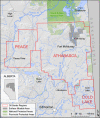A synthetic review of terrestrial biological research from the Alberta oil sands region: 10 years of published literature
- PMID: 34510725
- PMCID: PMC9292629
- DOI: 10.1002/ieam.4519
A synthetic review of terrestrial biological research from the Alberta oil sands region: 10 years of published literature
Abstract
In the past decade, a large volume of peer-reviewed papers has examined the potential impacts of oil and gas resource extraction in the Canadian oil sands (OS). A large proportion focuses on terrestrial biology: wildlife, birds, and vegetation. We provide a qualitative synthesis of the condition of the environment in the oil sands region (OSR) from 2009 to 2020 to identify gaps and progress cumulative effects assessments. Our objectives were to (1) qualitatively synthesize and critically review knowledge from the OSR; (2) identify consistent trends and generalizable conclusions; and (3) pinpoint gaps in need of greater monitoring or research effort. We visualize knowledge and terrestrial monitoring foci by allocating papers to a conceptual model for the OS. Despite a recent increase in publications, focus has remained concentrated on a few key stressors, especially landscape disturbance, and a few taxa of interest. Stressor and response monitoring is well represented, but direct monitoring of pathways (linkages between stressors and responses) is limited. Important knowledge gaps include understanding effects at multiple spatial scales, mammal health effects monitoring, focused monitoring of local resources important to Indigenous communities, and geospatial coverage and availability, including higher attribute resolution in human footprint, comprehensive land cover mapping, and up-to-date LiDAR coverage. Causal attribution based on spatial proximity to operations or spatial orientation of monitoring in the region is common but may be limited in the strength of inference that it provides. Integr Environ Assess Manag 2022;18:388-406. © 2021 The Authors. Integrated Environmental Assessment and Management published by Wiley Periodicals LLC on behalf of Society of Environmental Toxicology & Chemistry (SETAC).
Keywords: Athabasca; Biodiversity; Canada; Cumulative effects; Environmental monitoring.
© 2021 The Authors. Integrated Environmental Assessment and Management published by Wiley Periodicals LLC on behalf of Society of Environmental Toxicology & Chemistry (SETAC).
Conflict of interest statement
The authors declare that there are no conflicts of interest.
Figures



References
-
- Alberta Biodiversity Monitoring Institute (ABMI) . (2014). The status of biodiversity in the oil sands region of Alberta: Preliminary assessment. Retrieved August 23, 2019, from: https://abmi.ca/home/publications/1-50/40
-
- Alberta Biodiversity Monitoring Institute (ABMI) . (2017). ABMI human footprint inventory: Wall‐to‐wall human footprint inventory. Retrieved August 18, 2020, from: https://ftp-public.abmi.ca/GISData/HumanFootprint/2017/HFI2017v1_Metadat...
-
- Alberta Biodiversity Monitoring Institute (ABMI) . (2018). ABMI 10‐year science and program review. Retrieved August 23, 2019, from: https://abmi10years.ca
-
- Allen, C. R. , & Holling, C. S. (2002). Cross‐scale structure and scale breaks in ecosystems and other complex systems. Ecosystems, 5(4), 315–318. 10.1007/s10021-001-0075-3 - DOI
Publication types
MeSH terms
Grants and funding
LinkOut - more resources
Full Text Sources
Miscellaneous

